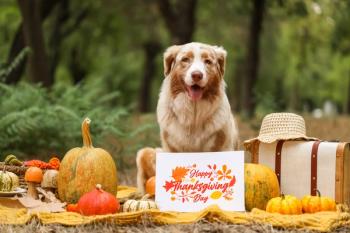
Tricks without treats ahead of Halloween
Pet owners learn vital Halloween safety tips as chocolate and other dangers threaten pets. Discover how to protect your furry friends this spooky season.
Last Halloween, Michelle Ruark and her family were planning to attend a trunk-or-treat event so she purchased a 90-ounce bag of mini candy bars. After hiding them inside a shower in their home, Rurak thought the candies were safe behind closed doors, until their dog Paige, a Labrador retriever, decided to help herself.1
“We don’t usually keep chocolate in the house,” Ruark explained. “A couple of nights before Halloween, we came home and found that Paige had literally knocked the shower doors off their hinges, and had eaten the entire bag of candy, wrappers and all.”
Renee Schmid, DVM, DABT, DABVT, and the team at Pet Poison Helpline received the call from Rurak and her family, leading them to work on calculating how much chocolate Paige ingested and factoring in her weight. The team determined that, combined with the wrappers, she ingested a toxic amount of candy. Based on this, the team was concerned about gastrointestinal upset, pancreatitis, polydipsia, hyperactivity, cardiovascular and central nervous system stimulation.
Paige’s family brought her to the Southern Rockies Animal Emergency + Specialty Hospital in Colorado, where their veterinary team induced emesis that resulted in a large amount of candy, still in the wrappers, chocolate, and additional empty wrappers. Based on the amount of chocolate recovered from vomiting, the concerns for severe clinical signs lessened and she was able to be treated and sent home to be monitored by her owners.
“Every kind of Hershey bar was in that bag,” Roark said. “The Pet Poison Helpline toxicologists looked up every single candy and calculated how much chocolate and other potentially dangerous toxins Paige ingested. By the time we got to the emergency room, they had already talked to our veterinarian and discussed a recommended treatment plan. I know that if we had just shown up at the emergency room, they wouldn’t have known how to treat her. Pet Poison Helpline saved our girl’s life.”
For the last 10 years, chocolate has been named a top toxin on Pet Poison Helpline’s Top 10 Pet Poisons of 2024 list, and dogs make up 95% of Pet Poison Helpline’s chocolate calls. Theobromine and caffeine, both found in chocolate, can result in vomiting, diarrhea, elevated heart rate, abnormal heart rhythm, hyperactivity, tremors, seizures, and even possibly death if ingested in toxic amounts.2
Other creepy cases
Ethan, a dog living in Philadelphia, Pennsylvania, also took spooky time to a new level after ingesting green trace dye, which is normally used to detected leaks in water systems and plumbing. Brian Barrett, Ethan’s owner, wanted to have fluorescent green water in his Halloween display and used the green trace dye because it glows under black light.
“I let my dog Ethan out the night before Halloween, and he drank a small amount out of the display,” Barrett explained. “The next day I took him out for a walk and his pee was neon green. The packaging said the liquid was safe, but I called Pet Poison Helpline to be sure. After they heard the details, and researched the ingredients in the dye, they told me what signs I needed to look for and saved Ethan from a trip to the veterinarian. Ethan is doing great.”
On the other side of the country, Lydia Robinson from Maricopa, Arizona caught her dog Shadow playing with a dead bat in their yard. Her other dogs, Gambit and Grim, were with the bat and Shadow as well, but it appeared Shadow was the only one in contact with the bat. Since all dogs were up to date on their rabies vaccinations and no wounds or bite marks were visible, they did not need a trip to their veterinarian but were given a list of signs to look out for. It was also suggested to Robinson to contact her local health department to determine if they wanted to test the dead bat for rabies.
Takeaway
According to Pet Poison Helpline, although ingesting candy and drinking fluorescent green water is a threat to pets, one of the greatest dangers pets face during Halloween is getting out of the house and getting into other types of dangers, like getting hit by a car or stolen.
“According to our partners at AKC Reunite, October is the second highest month for lost-and-found pet reports,” Schmid explained.1 “Pets get anxious from multiple trick-or-treaters coming to the door, and with each visitor you greet, your pet has an opportunity to sneak out and escape the chaos. A loose pet at night is especially dangerous because they cannot be easily seen by motorists.”
Reference
- A Poisonous Halloween for Pets. News release. Pet Poison Helpline. October 8, 2025. Accessed October 9, 2025.
- Chocolate. Pet Poison Helpline. March 3, 2020. Accessed October 9, 2025. https://www.petpoisonhelpline.com/poison/chocolate/
Newsletter
From exam room tips to practice management insights, get trusted veterinary news delivered straight to your inbox—subscribe to dvm360.






